Blackview Tab 18 12″ Android Tablet Review
Dustin Abbott
March 29th, 2024
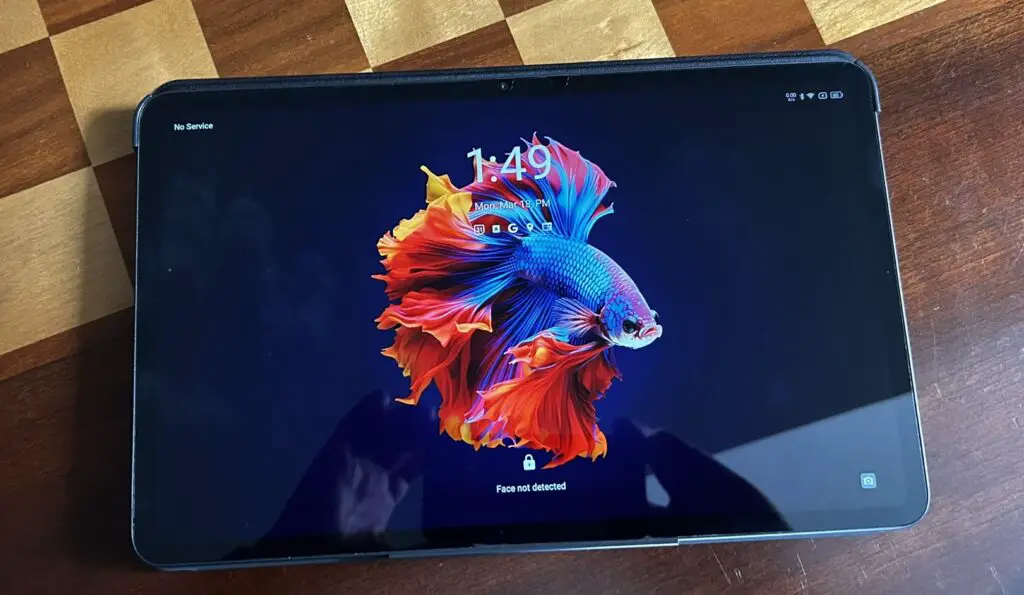
I’ve made it a habit to schedule tablet reviews around the time that I’m traveling, as it gives me a chance to leave my go-to tablet (an iPad Pro 11″) at home and see how the new device works as a replacement. I’ve recently done that with the Blackview Tab 18, a new 12″ Android 13 tablet. It probably bears more similarities to the Doogee T30 Pro that I reviewed in 2023 than to my Apple product, so I’ll draw some comparisons to the T30 Pro as a part of this review. Overall I came away impressed with some of the key details of this budget (under $300 USD) tablet that does most of the important things very well. Most importantly is the excellent performance of the screen and speakers, an area where the Blackview Tab 18 sets itself apart from some of the other budget tablets that I have reviewed. You can find out more in my thorough video review here.
Screen Performance
The Blackview Tab 18 sports an 12″ 2.4K (1200 x 2000 pixels) IPS panel that is nice and bright. Blackview touts an 86.6% screen-to-body ratio, meaning the bezel surrounding the screen is nice and thin.
The tablet measures 277mm (10.9″) x 173mm (right under 6.8″), making it larger than Doogee T30 Pro, which is 10” in height (254mm) x 6.5” in width (165mm). The T30 has an 85% screen-to-body size, so the Tab 18 also maximizes the screen size relative to the tablet a little better (86.6%). My iPad Pro 11” has a different screen ratio, with a height of 9.74” (247.6 mm) and width of 7.02” (178.5 mm). I like the dimensions of the Tab 18 better for media viewing, but prefer the iPad’s dimensions for general purpose use.
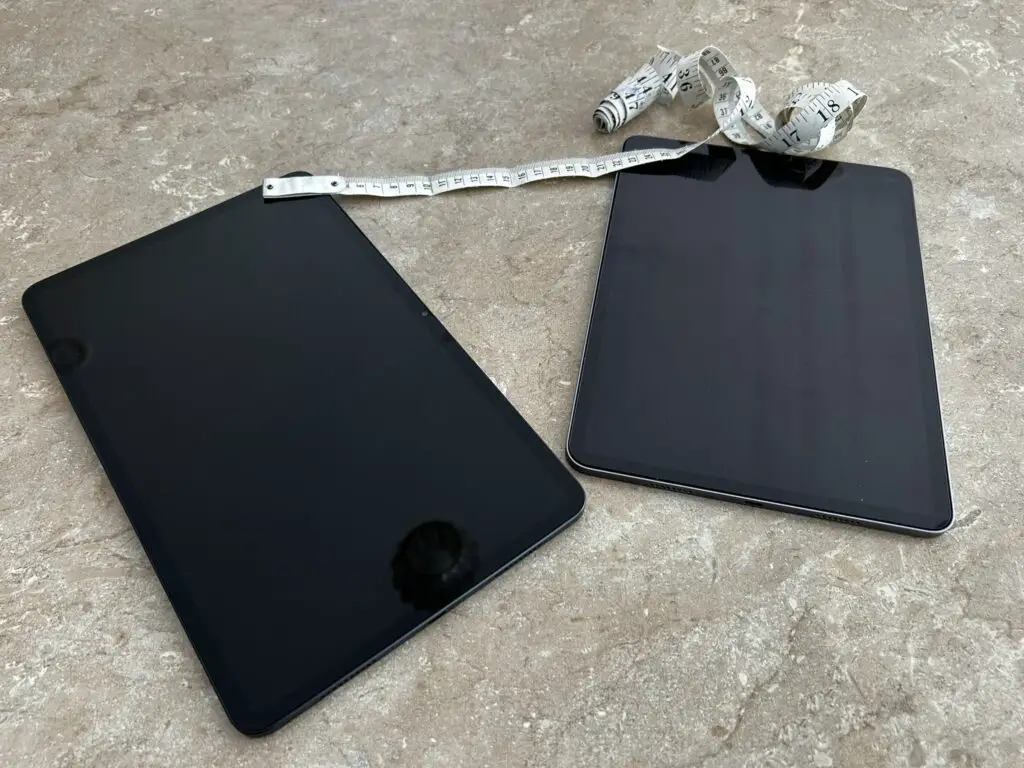
The depth of the Tab 18 is 7.9mm, making it very slightly thicker than the T30 Pro (7.6mm), but more noticeably thicker than my iPad Pro, which is just 5.9mm. The Tab 18 is also the heaviest of three tablets at 632g (T30 is 543g | iPad Pro 473g), though, to be fair, it is slightly larger than them as well. When you account for that, the Doogee and Blackview tablets are near identical in their size to weight ratio, though the iPad is clearly the winner in that regard. The iPad Pro is noticeably thinner than the Tab 18.
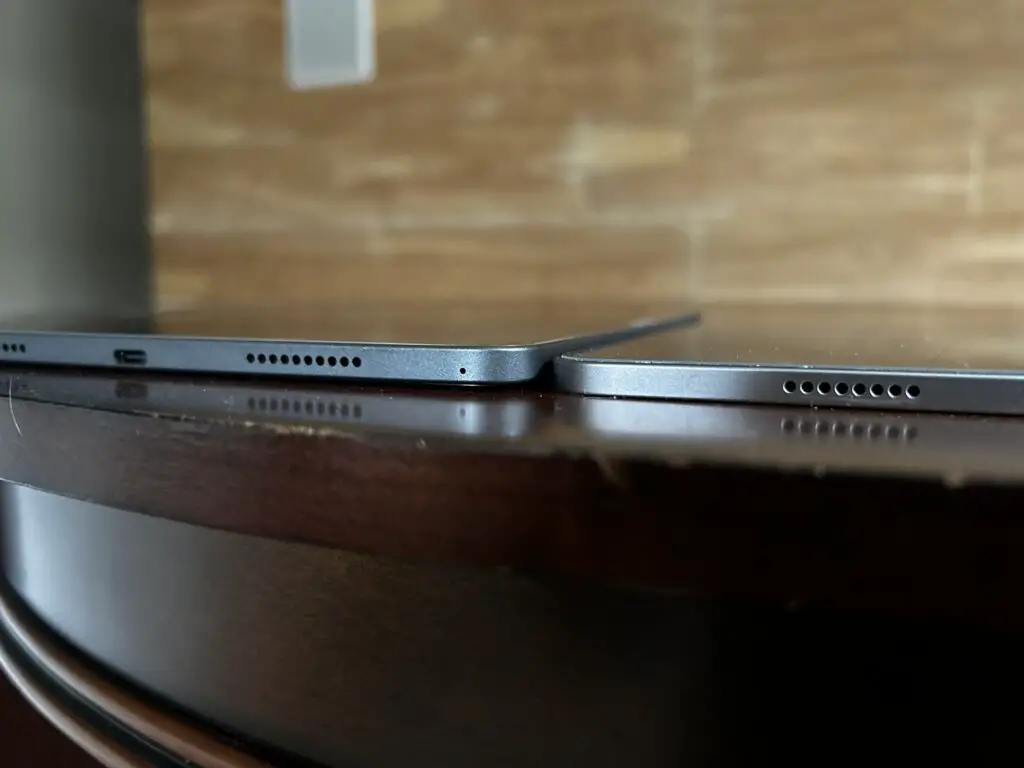
Obviously the minute difference between the Doogee T30 Pro and the Tab 18 wouldn’t be noticeable.
I do like the wider ratio for one other thing, however, and that is when putting two programs side by side in split view or in the optional PC mode that the tablet offers (basically the ability to have “windows” that can be resized to whatever dimensions you like). I also liked the the fact that the operating system will use local dimming to make the active window (in this case, my Word text document) brighter than the inactive window, helping you to remember which you are actively working in.
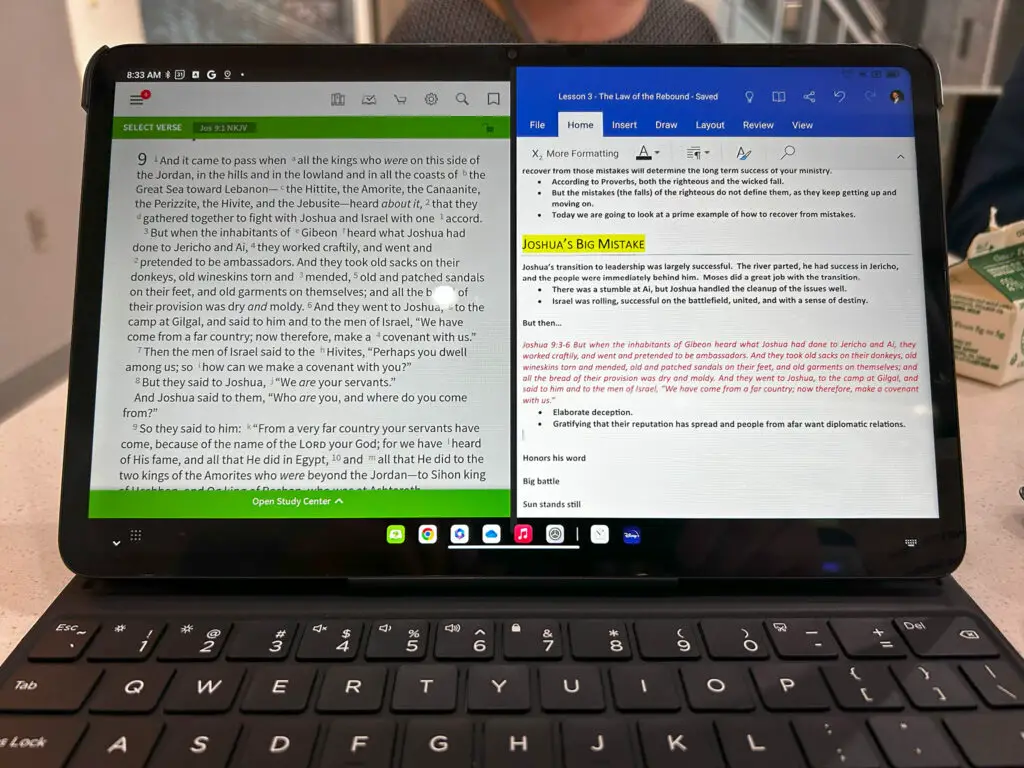
I used this while on my trip to prepare for a leadership mentoring class I’m teaching at the church I pastor.
On paper, the Doogee T30 Pro has a higher resolution (1600 x 2560), but I actually preferred the display on the Tab 18. While both screens have a rated 350 nits of peak brightness, the screen on the Tab 18 had a better viewing angle with less tendency to look dark if you were slightly off angle, making the tablet much better for sharing the view between two people (like when watching media).
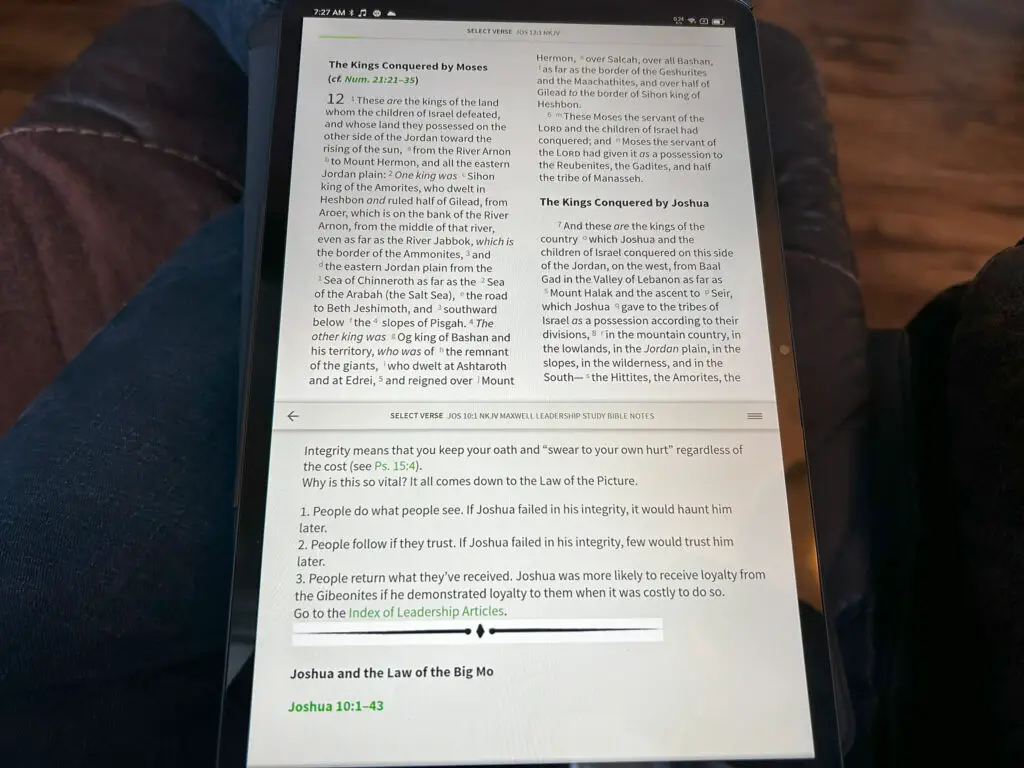
I typically spend time every morning reading the news and studying my Bible app, and I find that the bottom or top of the screen (depending on the tilt) looks darker than the other due to the viewing angle on the Doogee T30 Pro, but the Tab 18 was closer to my iPad Pro in performance here and I immediately noticed the difference when I used it in my morning routine or watched something with my wife on it in the evening.
There is plenty of brightness for any viewing situation, and I found that I always had brightness at the 50% threshold or less, though as is common with tablet screens, the very reflective surface means that if you have a bright light source behind you (like a window), you will get a lot of reflections on the screen. Glossy screens look great in optimal conditions, but I often wonder if a more matte finish wouldn’t be more versatile. It is also a magnet for fingerprints and smudges, but that’s true of every tablet screen I’ve ever used.
One interesting option is the ability to engage reading mode. This turns the screen black and white and makes for an excellent reading tablet. You can see that the text is impressively crisp and the long perspective of the tablet in vertical mode (it is a 5:3 aspect ratio) makes for a nicely book-like experience.

I’m still partial to a dedicated e-reader because of the less reflective screen and near-eternal battery life, but if you want one device to do it all, here’s another score for the Tab 18. It also has TÜV SÜD blue light certification, meaning that the screen will be easier on the eyes and less disruptive to sleep cycles, which is a welcome feature.
On the more negative front, I have yet to find an Android tablet where the adaptive brightness works as well as on iPad. There is a sensor for it on the front of the screen, but I do find that it tends to result in a too-low brightness level. As with other Android tablets, I end up disabling it and just doing manual adjustments to brightness as need (which frankly doesn’t feel very often).
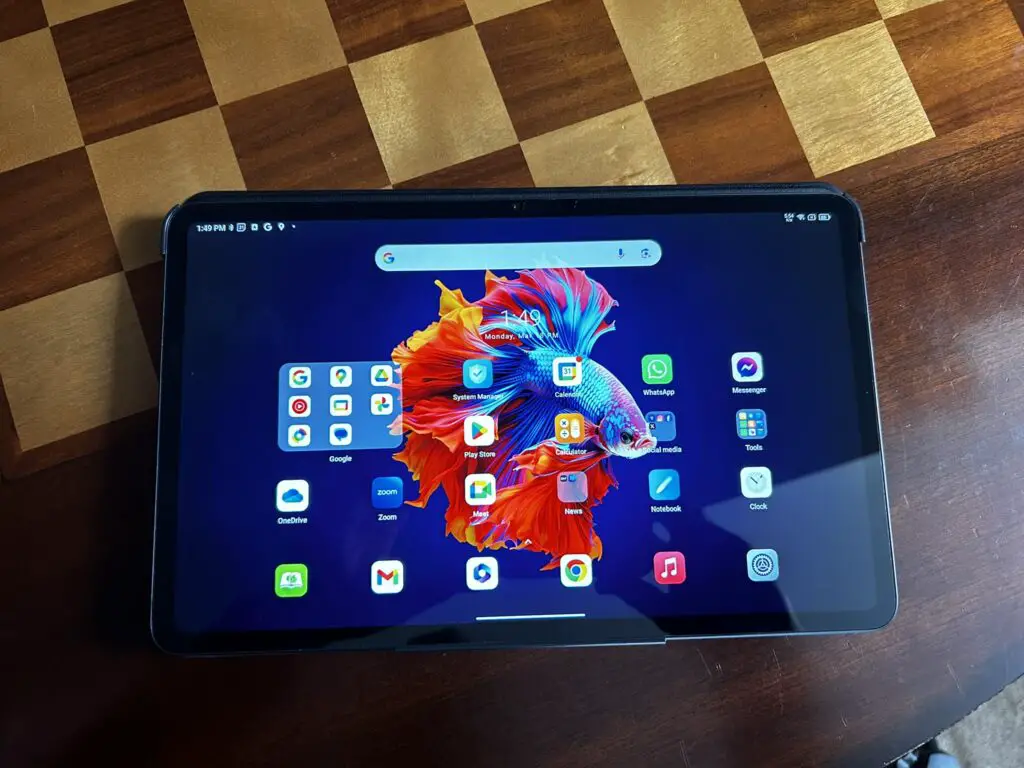
The Tab 18 really thrives as a media viewing device, as the screen is very crisp, has great color, and also has Widevine L1 Support.
What does that mean? Technically, Widevine L1 is the highest degree of DRM protection achievable in a media device, meaning that video decryption and processing take place entirely within the Trusted Execution Environment in the device.
Who cares about that, right?
But where that pays off for you is that Widevine L1-certified devices can play videos at the best resolution possible from streaming services, meaning that your movies and shows will look great. I found good color balance when viewing the screen critically.

The wide aspect ratio makes for a very effective portable media screen, and it is here where the Tab 18 makes the most of its 12″ screen. Side by side, it can’t match the detail of my 3x more expensive iPad, but I think that most people will be pleased with how this screen looks and performs.
Audio Performance
To this point, none of the Android tablets have come anywhere close to matching the excellent sound quality of my iPad Pro. It’s quad speakers are immersive, have a surprisingly full range of sound, and can achieve impressive volume without falling apart. The Blackview Tab 18 is the first inexpensive tablet that has come close to matching it. This is one area where the Doogee tablets have disappointed, with very tinny sound and an artificial amount of reverb designed to create presence where it is lacking.
None of that is true here. I wasn’t expecting much after my previous experiences, though I did have a minor bit of hope based on the fact that Harman had lent their name to the audio design here. They are a very serious audio company, and they have come through with an impressive performance here on both the hardware (quad speakers) and software (Harman AudioEFX 2.0) side. The Harman AudioEFX 2.0 comes with multiple sound enhancement modes and I did find that cycling through the audio options made a difference. Switching to Movie mode allowed for a little more volume and a slightly wider soundstage (Game mode was just a bit “wider”). Music mode feels a little less processed and doesn’t add unnecessary reverb. There is a Smart mode that will choose the appropriate audio mode, but I actually found that manually choosing the correct mode produced slightly better results.
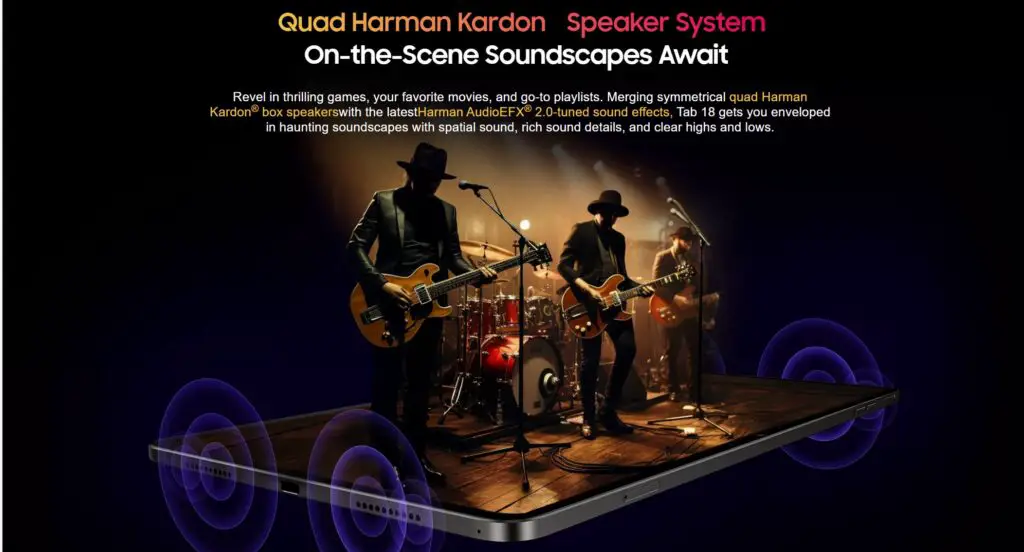
The T30 Pro just sounds tinny next to the Blackview Tab 18, so I did more side by side comparisons with my iPad Pro. I listened to music and movie clips one after the other, and I was hard pressed to say which I preferred. At first I would have said “iPad”, but choosing the correct processing mode closed that gap. I think the iPad may have ever-so-slightly better bass, but it’s so close that I wasn’t 100% sure even side by side. The Tab 18 was very close to matching the presence and spatial separation of the iPad, which vastly exceeded my expectations.
I was equally impressed to find that the Tab 18 could match the peak volume level of the iPad for movies or music, which is impressive. Neither the Tab 18 or the iPad fell apart at peak volume, which shows that in both cases the manufacturers have done a good job of limiting the peak volume to what the hardware can handle. There’s enough sound here to fill most normal sized rooms
My only complaint is that Blackview has followed the current trend where they have eliminated the 3.5mm headphone jack, leaving you to rely on Bluetooth or a USB-C to 3.5mm adapter.
The audio performance is WAY better than any other budget tablet that I’ve reviewed or used.
Connectivity
Here we come to an area where Apple is, frankly, terrible, and where these Android based tablets shine. It’s astonishing that after all this time Apple is getting away with charging massive amounts for additional storage. An iPad Pro 11” like mine starts at $799 for a Wi-Fi only configuration and 128GB of internal storage. Want more storage? The price jumps to $899 to get to the 256GB internal media point, and $999 to get 512GB. Want wireless mobility? Add another $200 to those prices. Want to add more storage after the fact? Fuggedaboudit.
The Tab 18 comes with 256GB of internal storage, but you can easily expand that to as much as 1TB via microSD. It’s not hard to get a 1TB card for under $100, so there’s a very clear advantage for the Tab 18 over Apple products. That’s not to mention that it also has dual SIM, though they are limited to 4G/LTE rather than the 5G available on iPad. Note that the microSD for storage will occupy one of those slots, but you can otherwise run two different networks at the same time. Still, an equivalent iPad will cost you about $800 more. That’s probably the most compelling argument for the Tab 18 right there; it is a huge value.

Further connectivity comes via 4 different satellite positioning options, including GPS, GALILEO, BeiDo, and GLONASS. Wireless specs include 802.11 a/b/g/n/ac, dual-band, Wi-Fi Direct, and hotspot, which is fast and stable, though I did find that it didn’t clock as fast of speeds as my iPad. Still fast enough to not really notice the difference.
Charging and communication comes via a USB-C port. You can attach other accessories like a mouse via the USB-C port or create a direct connection to a PC.
There’s one area where I prefer the Doogee T30 Pro, and that’s in the connection to the optional keyboard. The T30 has electronic contacts on the side (like my iPad), which allow for a direct connection that can transfer both power and data directly. With this kind of the connection the keyboard (like iPad) will run off the battery of the T30 Pro, meaning that the keyboard does not require a separate power source. It doesn’t have to be independently charged, so you will never go to use it and find that the keyboard battery is dead. This also eliminates any possibility of Bluetooth lag.
The keyboard for the Tab 18 connects via Bluetooth and has an independent battery (charges via USB-C). Keyboards like this use very little power, so thus far I have not had to recharge it. Bluetooth lag is fortunately very minimal, so that hasn’t been a serious issue. I do like the keyboard case, as it magneically locks into a good viewing and won’t fall over (an area where the included case is weak). You can even lift up the tablet and the keyboard will stay locked in the right place.
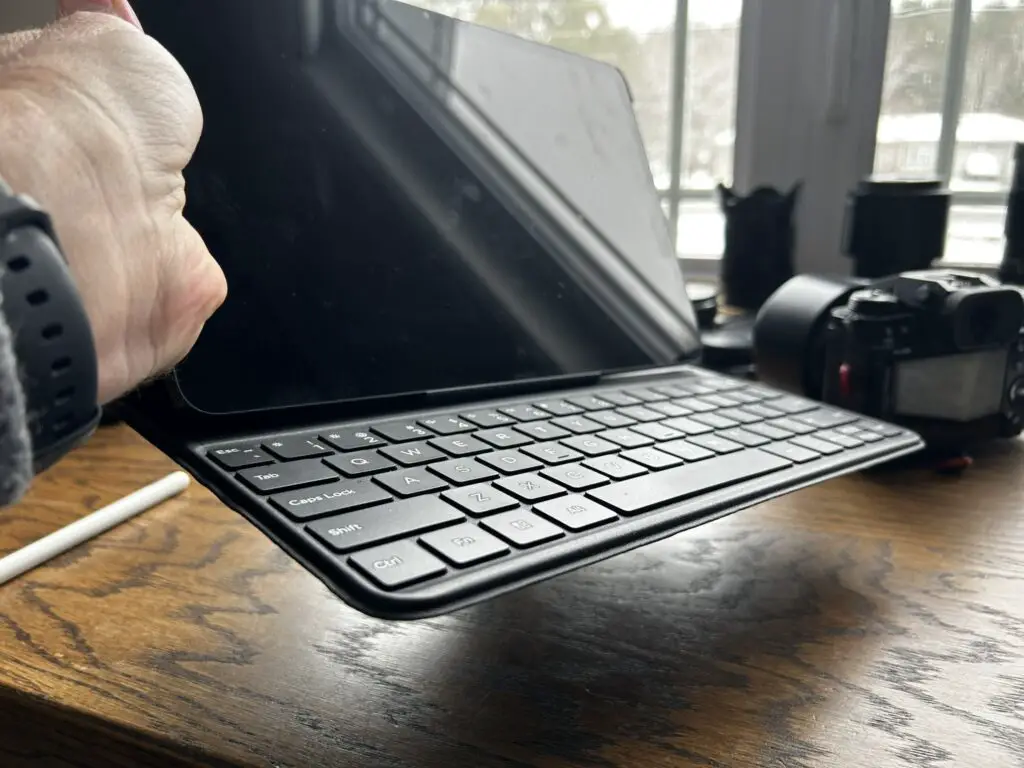
The keyboard can be had for just $39.99, so it represents a huge value compared to my $280 USD Magic Keyboard for my iPad. I’m actually thankful that this keyboard (unlike the Doogee) foregoes the touchpad, as I actually found that as my palms brushed it (while typing) it would move the curser around and mess me up. I actually covered it after a while because it could not be disabled. The Blackview keyboard does have variety of controls (volume, brightness, audio controls, etc…), and directional controls. It is not backlit like the Magic Keyboard, but it does have excellent typing action, reminding me a lot of the ribbon action of the Magic Keyboard. The keys are nicely responsive, the spacing is good, and it is comfortable to type on.
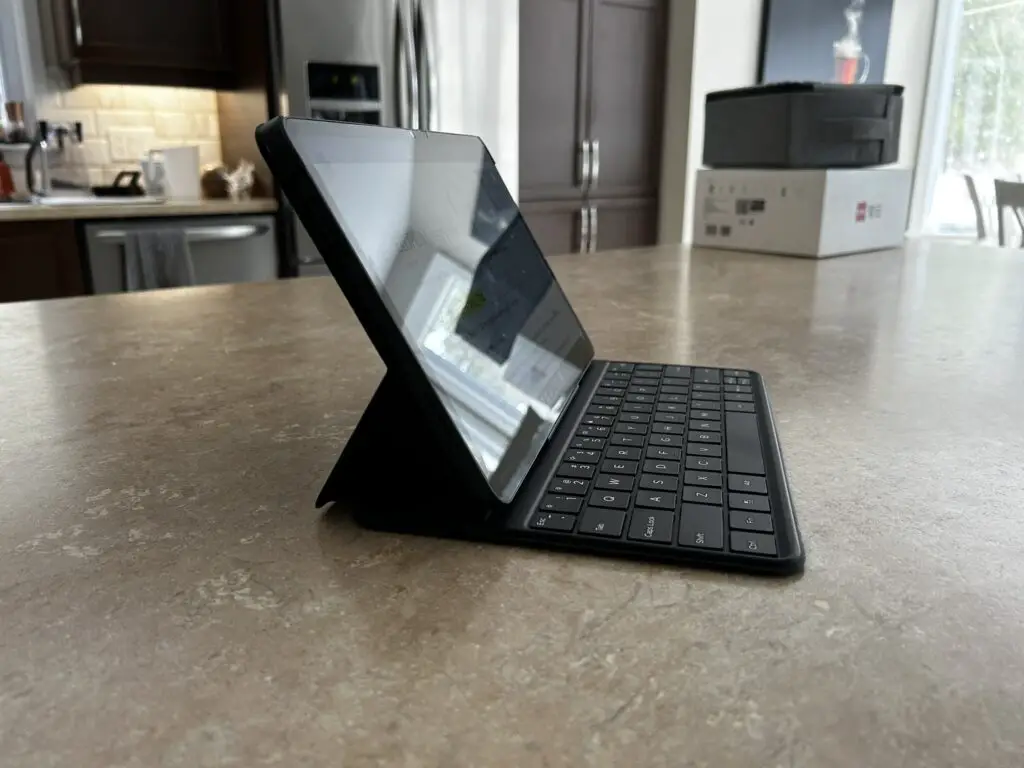
The kickstand integration on the Doogee keyboard was terrible, so the magnetic integration here is a breath of fresh air.
Blackview also sells an active, touch capacitive “pen”/stylus for about $46 (again, a fraction of the price of the Apple counterpart). It works in a similar fashion to the Apple “pencil” that I’ve used in the past, allowing you to draw, write, or interact with the screen in various apps. It is simple to charge via the USB-C port hidden on the side. It does magnetically dock to the side of the tablet, which is an improvement over the Doogee equivalent.
The Blackview Tab 18 allows you to build the full ecosystem of modern tablet use (keyboard, active pen) for less than $100 of additional money. The total for all three (including the tablet) was juts $365 USD…only slightly more than just the Magic Keyboard alone for my iPad!!
Processor Performance
The hardware side of things is pretty typical for an Android tablet of this class. It seems that most of them have pretty much the same specs. It comes bundled with Blackview’s own version Android 13 (called DokeOS_P 4.0), and it is overall snappy performer. It is running a MT8781 (Helio G99) OctaCore processor (2 Cortex-A76 and 6 Cortex-A55 processors) with the cores running at 2.2GHz and 2GHz respectively. It is a 6nm processor, pointing to solid efficiency and performance. Where the Tab 18 exceeds previous Android tablets I’ve tested is that there is the option for up to 24GB RAM (as in the Tab 18 I’m testing), with 12GB DDR4X natively + Up to 12GB Extended (virtual) RAM that can be set up in the dashboard. I obviously accustomed to working on and using what is one of the most powerful tablets currently available in my iPad, and I found that I didn’t notice any real slowdown that stood out to me. Apps open quickly, and using my normal apps feels virtually identical to my iPad Pro, though I do find some apps a little more glitchy on Android.

I’m not a big tablet gamer, but I did test a number of games, including Call of Duty, Oceanhorn, and Angry Birds 2. Call of Duty allowed me to run things at high resolution and without any lag issues. Colors were nice and bright on other games, and the screen touch was responsive for gaming input.
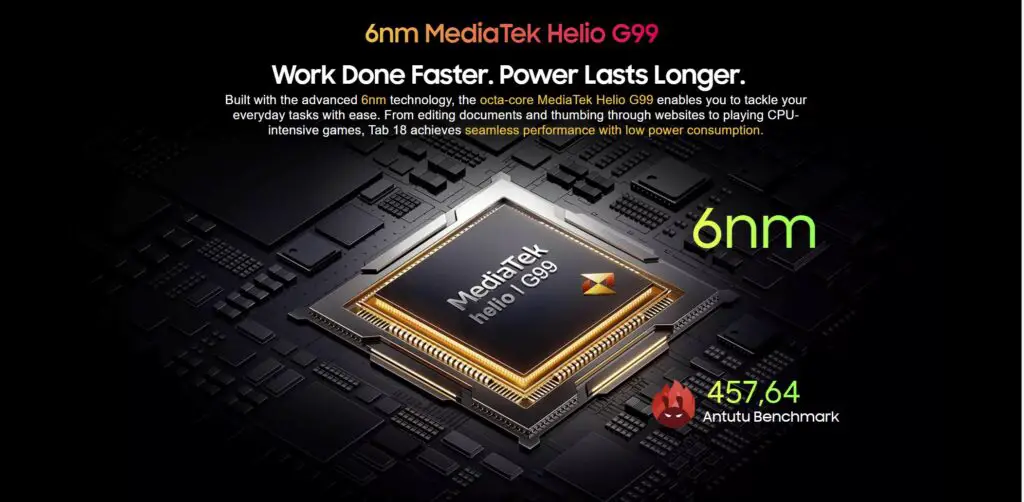
More importantly for me, I was able to run office and productivity apps without issue. Video streaming programs ran excellent. There seems to be plenty of power under the hood to do whatever I wanted to do here.
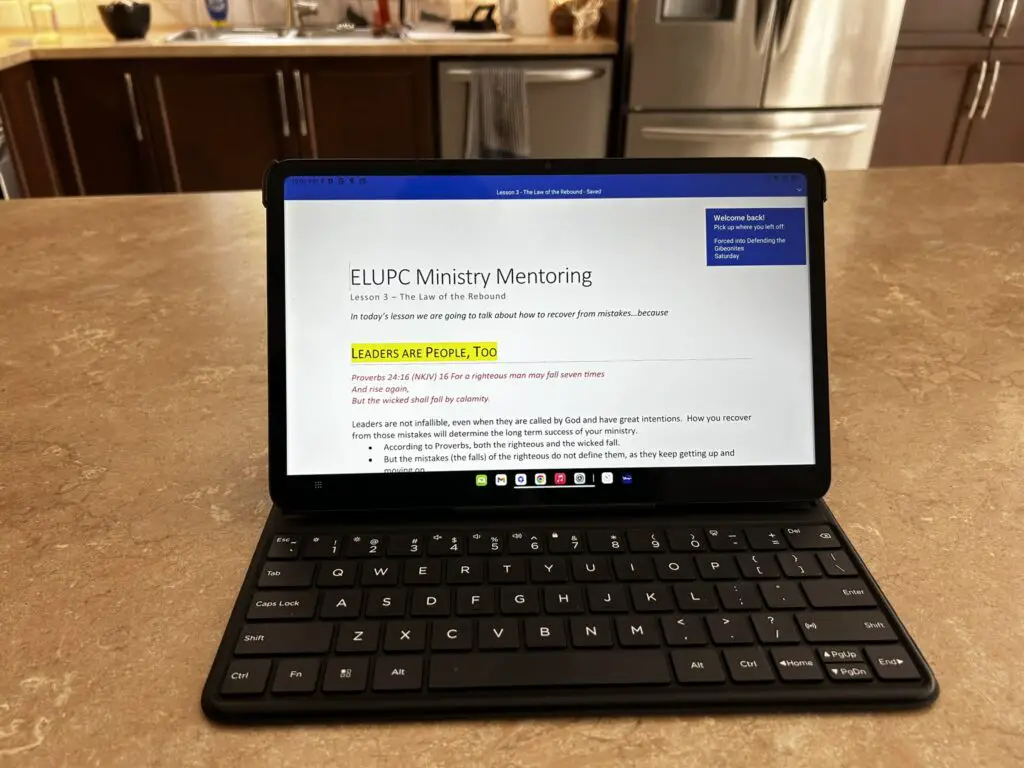
My one complaint here is that booting the Tab 18 up from fully powered down takes longer than what I would like.
Battery Life
One of the very best features here is the huge 8800mAh Battery (slightly bigger than on the T30). Battery life is great, and I found that in a few select instances where I was doing something I regularly do on my iPad, there was a bit more power remaining than I typically see afterward. Both the included cover and the keyboard covers are “smart”, so you can just close the cover to power down the screen.

Charging comes at a maximum of 33W (the T30 Pro maxes out at 18W), allowing you to fairly quickly replenish the battery (though, as is often the case, I was sent the wrong spec AC adapter for North America). Fortunately I have a lot of charging options already available, and I found that charging was fairly pain-free.
I was able to do everything I wanted in any particular day with power to spare.
Cameras and Videoconferencing
It’s a little ironic to me, but I found two things to be true about the Blackview approach to cameras. Doogee is very big on the marketing of their cameras both in the brand and the resolution. By contrast, Blackview makes less of a big deal about the cameras but actually delivers better results. The main (back) camera is a 16MP model supported by a small LED flash.

There is also an 8MP front camera. I found that the main camera did a fairly good job and didn’t have the oversharpened look so common to Android tablets.
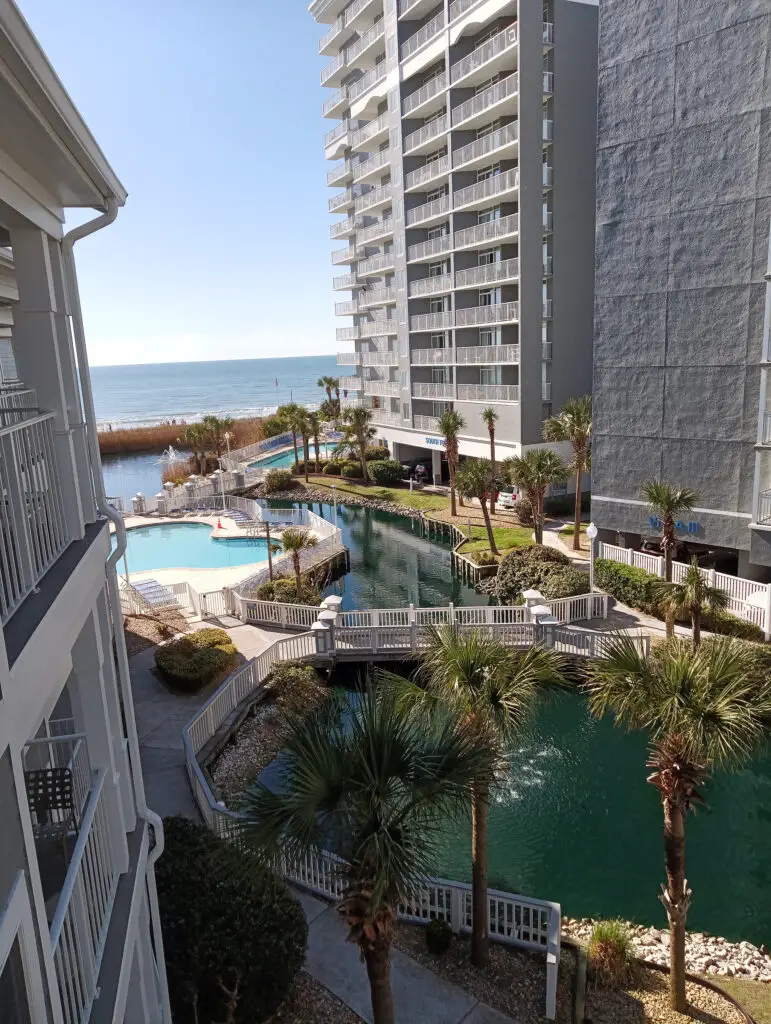
As a professional photographer who owns a number of high end cameras, I’m certainly not going to be relying on the camera in a tablet for my photo needs, so I didn’t use it much. I can quickly see the limitations in this type of camera performance, but relative to other tablets, it was pretty decent.
I’m more concerned with the front camera and its performance for Zoom or other videoconference apps. Videoconferencing, fortunately, works very well. Unlike iPad, the front facing camera is located mid-screen, which works better for being able to make eye contact with whomever you are talking to. I’ve used Zoom, Google Meets, etc… and even some proprietary conferences with corporations, and all has worked well. I could hear and see them well, and vice versa, even when just using the standard mic and speakers built into the Tab 18.
Build and Design
The Tab 18 sports a very nice aluminum chassis with three color choices: Gray, Mint Green, and Ice Blue. I’ve got the tamest color choice (Grey), that has a nice, clean, modern design.
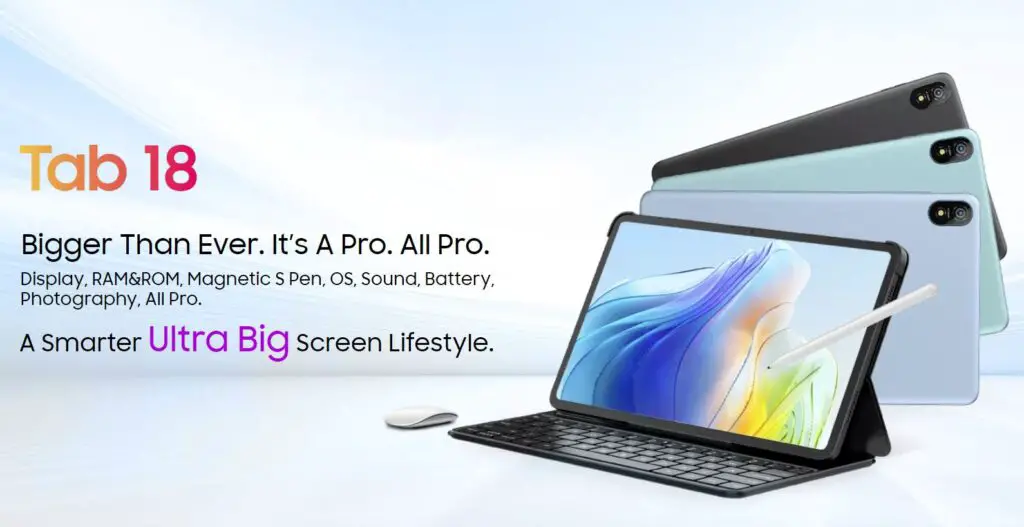
There’s a nice feeling bevel to the back design with a very light texture, though I still wouldn’t want to try to hang onto this without a case very much.

It comes with a glass screen protector installed (excellent!) along with a spare (also excellent!) It is one of the rare recent tablets/phones that I’ve reviewed that came with a bundled set of wired headphones (with a USB-C plug instead of a 3.5mm). The AC adapter along with a USB-C to C cord was also included. Rounding out the package is the smart cover (which keeps everything nice and slim and giving you easy “awake” features).
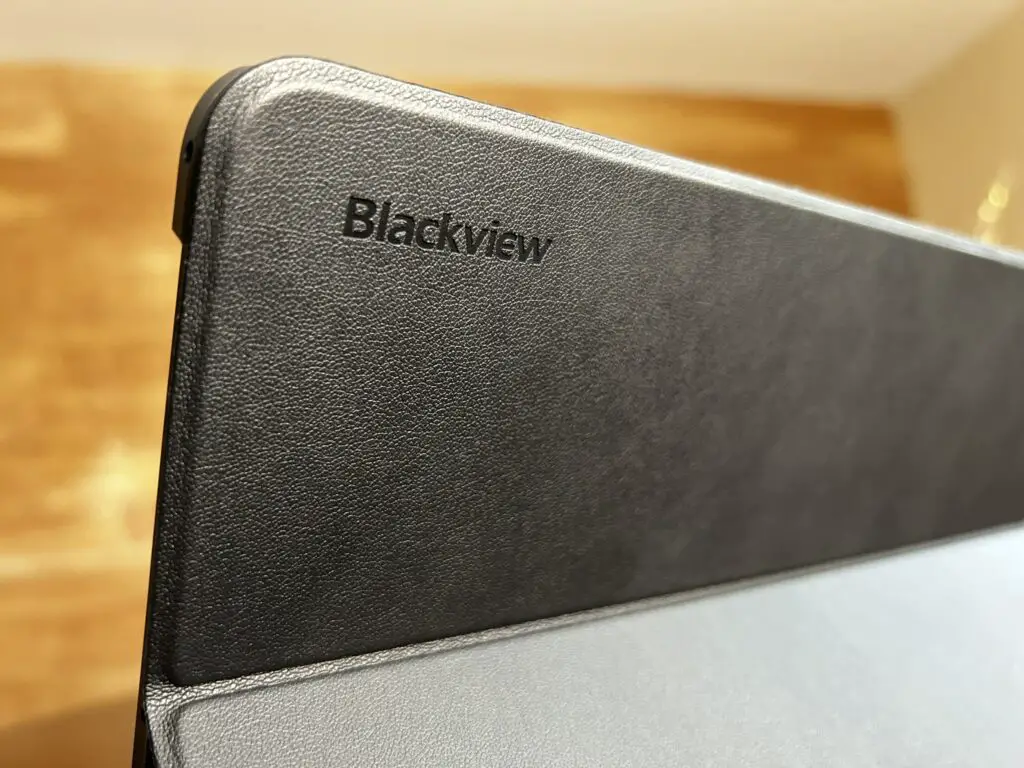
As alluded to earlier, I was less than impressed by the smart case’s ability stay upright. There is a single groove that you can tuck into in either direction (laptop style or folding it into a support at the back), but the slightest bump knocks it out of the groove and the tablet with collapse. I would have loved to see a magnetic implementation similar to the keyboard case instead. The accessory market for a tablet like this isn’t as robust as for Apple products, but fortunately it does come bundled with a lot of things one might want. There are a few alternate cases available already on Amazon, so I may try one of those out in the future.
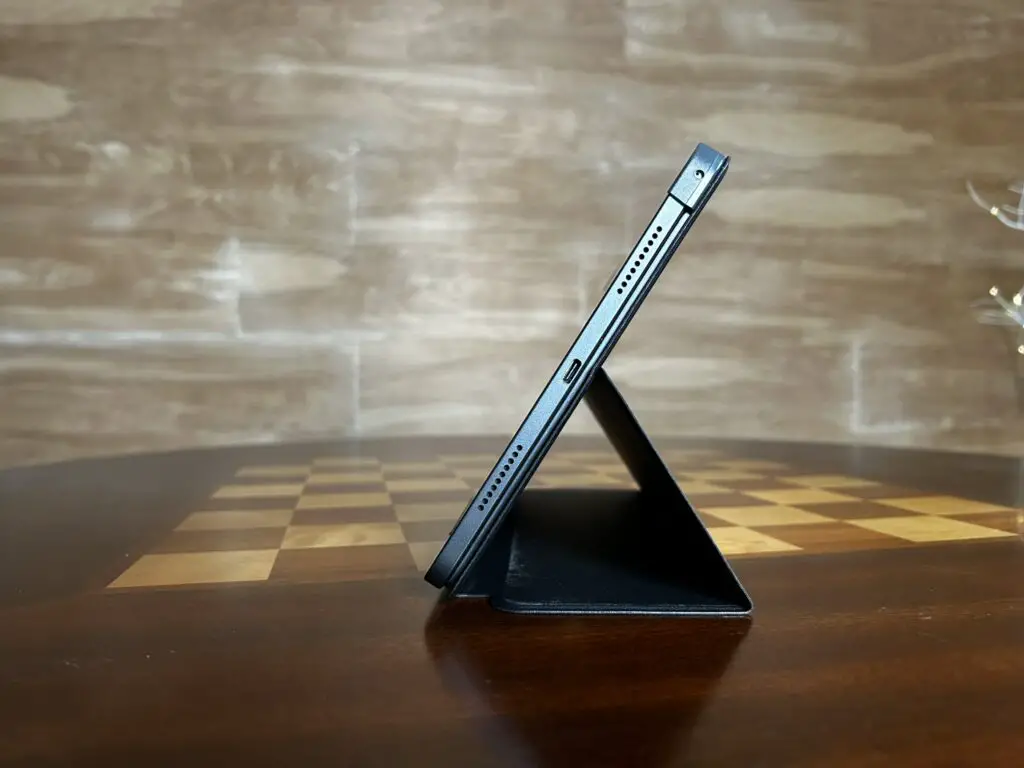
Also included is the little tool to allow you to access the Nano-SIM slots or to install a micro-SD card. I didn’t test the mobile capacity of the tablet, as Canada is (unfortunately) quite primitive when it comes to reasonable mobile plans whether talking phones or tablets).
Security features include a fingerprint reader (which doubles as the power button) and face recognition. Both work quite well for this level of tablet, making getting into your device nice and quick.
Conclusion
I’ve reviewed a number of tablets at this point, and owned many others, and I can safely say that the Blackview Tab 18 is my favorite budget tablet to date. It really delivers in some key areas, including screen and sound performance, battery life, and a great size. And the price, of course, is fantastic. You get more screen area and more RAM than equivalent priced tablets, and it was the 12″ screen that made me say “yes” to doing this review when I’ve said “no” to many others. This is my first experience with Blackview, but I’m impressed enough that I hope it won’t be the last.
Purchase the Blackview Tab 18 from Blackview Store or from AliExpress: (use code E4KH6X for a $5 discount from March 28th – April 7th, 2024).
Want to support this channel? Use these affiliate links to shop at: B&H Photo | Amazon | Adorama | Camera Canada | Amazon Canada | Amazon UK | Ebay | Make a donation via Paypal
Buy DA Merchandise https://bit.ly/TWIMerch
Keywords: Blackview, Tab 18, Blackview Tab 18, Blackview Tab 18 Review, Tab 18 review, Blackview Review, 12″, Doogee T30 Pro Review, Tablet, Dustin Abbott, Hands On, Productive, Media, Battery Live, Android, Android 13, iPad, iPad Pro, 11″, Let the Light In, Widevine L1, 33W, #letthelightin, #dustinabbott, #DA, #reviews, #Technology
DISCLAIMER: This article and description contains affiliate links, which means that if you click on one of the product links, I’ll receive a small commission. As an Amazon Associate I earn from qualifying purchases.










 Nikkor Z 35mm F1.2 S Review
Nikkor Z 35mm F1.2 S Review  Kase AF 85mm F1.4 Review
Kase AF 85mm F1.4 Review  Fujifilm X-Half Review
Fujifilm X-Half Review  Nikkor Z 35mm F1.8 S Gallery
Nikkor Z 35mm F1.8 S Gallery 


